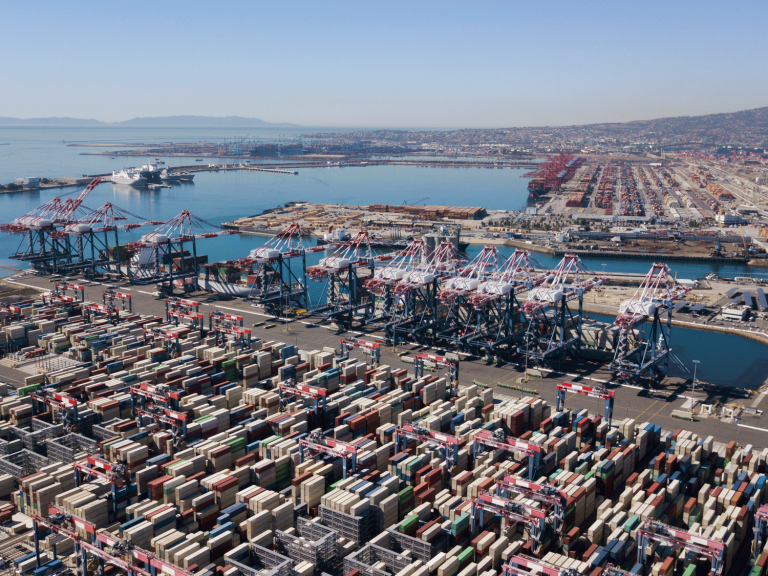
Date:
US market update: Navigating high demand and looming strikes
Shippers in the US are currently navigating a particularly challenging landscape, marked by elevated air cargo demand and looming threats of labour strikes on the East and Gulf coasts.
Air Cargo
Air cargo on the main trade lanes out of Asia remains in peak season mode. The situation is driven by distressed cargo from the Red Sea and sustained eCommerce demand, keeping spot rates high. The recent global IT outage at Microsoft, which caused massive flight delays, cancellations, and cargo backlogs, did not significantly impact the air freight market. Cargo load factors returned to normal levels within ten days.
Air freight rates from Shanghai to North America are currently 25% higher than last year. Growth in air cargo demand is expected to continue into August and September, with potential for further increases if the peak season extends into the fourth quarter.
Sea freight and the threat of East and Gulf coast strikes
The International Longshoremen’s Association (ILA) is seeking an 80% wage increase over its next six-year contract with maritime employers on the East and Gulf coasts. The ILA has issued a 60-day strike notice to the United States Maritime Alliance (USMX), warning of strike action by its 45,000 members if a new deal is not reached before the current contract expires at the end of September.
The ILA’s wage demand is significantly higher than previous agreements and follows other union victories in contract negotiations. Shippers using container ports along the US East and Gulf coasts have limited options if the ILA begins strike action on 1st October. Importers are advised to front-load cargo to these ports as outbound capacity from Asia has been tight for several weeks. Space on vessels needs to be booked immediately to ensure arrival by 30th September.
Canadian routings for inbound cargo are increasingly uncertain due to the threat of a country-wide rail strike, while diversions through Mexico present significant logistical challenges, including limited vessel space. Short ILA stoppages can be managed with East Coast ports capable of clearing backlogs quickly. However, prolonged stoppages of a week or more could take a month to recover from, causing widespread disruption.
Diverting services to avoid the US East and Gulf coasts poses its own challenges. West Coast capacity and container equipment shortages are likely to worsen, with US imports expected to increase by 14% year-on-year in August and resilient consumer spending maintaining demand. The current rate differential between East and West coasts is the widest since October 2022 but is expected to narrow as East Coast spot rates decline ahead of the potential ILA strike.
Carriers are booked through mid-August to the East Coast, keeping rates high at least for the next few weeks. However, this will change rapidly if the ILA takes action. Spot rates to the West, East, or Gulf coasts are unlikely to fluctuate significantly in the event there is no ILA strike. Additionally, no significant drop in rates is expected during the traditionally slow months of November and December.
Canadian Railways and unions resume contract talks
Canadian National Railway and Canadian Pacific Kansas City have resumed separate contract talks with the Teamsters Canada Rail Conference, representing nearly 10,000 railroad workers. Negotiations began last November but have yet to produce a new contract to replace the agreement that expired at the end of last year.
The Canada Industrial Relations Board is investigating whether a work stoppage would impact Canadians’ health and safety, with an announcement expected by Friday. While railroad workers cannot legally strike until 72 hours after the board’s ruling, the union has indicated that a work stoppage is likely by the end of August. A strike by Canada’s railroad workers would disrupt the daily movement of more than 900,000 metric tons of goods on Canada’s railways.
The US market is experiencing significant challenges in both air and sea freight sectors. With elevated air cargo demand and potential labour strikes on the East and Gulf coasts, strategic planning is more crucial than ever for shippers.
We are here to keep you informed and act proactively to help you navigate these turbulent times, ensuring the smooth movement of goods through your supply chain.
If you have concerns about potential ILA strike action, we can assess your situation and, if necessary, develop contingency plans to safeguard your import traffic. By exploring alternative access ports and adopting a collaborative approach, we will provide optimal solutions to meet your supply chain needs.
To learn how we can support your trade with the United States or for more information about our ocean solutions, please EMAIL our Chief Commercial Officer, Andy Smith.
